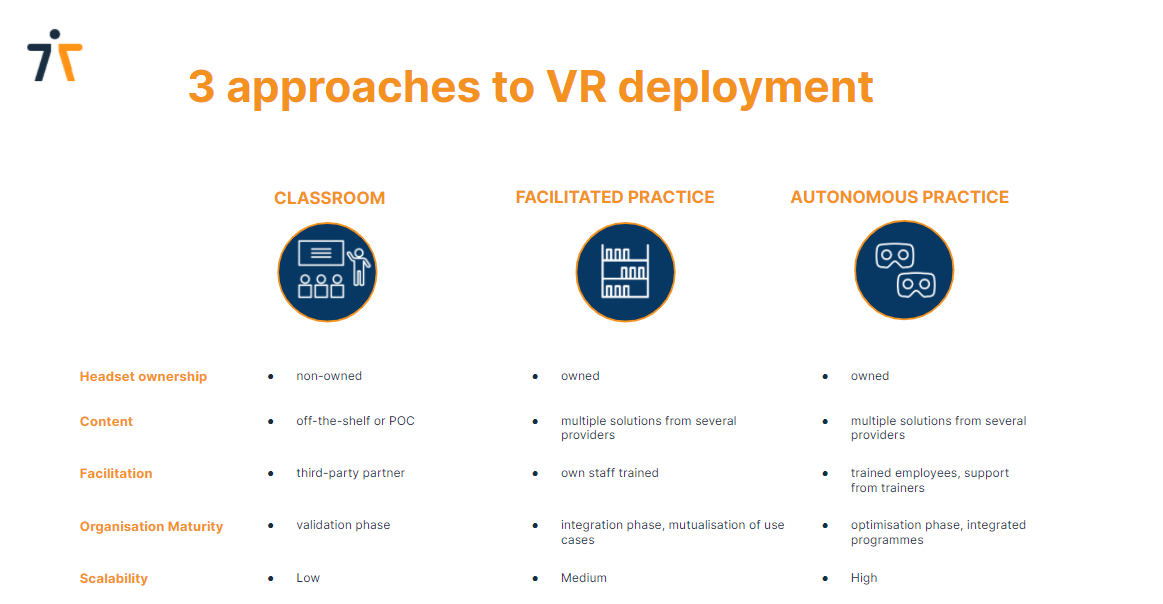VR for Soft Skills: moving from "Why" to "How"
Academic research results and case studies have firmly established VR as a powerful tool to accelerate behavioral change. In the past 6 months, the conversation around the use of immersive technologies for soft skills training has therefore moved from “Why” to “How”, from the value proposition to tangible VR deployment tactics.
Now, with the COVID-19 crisis impacting the L&D landscape, the pace of change has dramatically accelerated. In an increasingly decentralised and automated world, soft skills training is a strategic imperative to guarantee operational efficiency. But in this uncertain economic context, soft skills training budgets are likely to shrink and shift. Organisations are looking to move away from costly, carbon-hungry and potentially unsafe face-to-face approaches and instead develop new ways to deliver remote learning whilst justifying every penny spent by measurable results.
In this new world, VR becomes the best medium to deliver immersive learning experiences remotely. But how can organisations deploy VR, cost-efficiently and at scale? What’s the safest path from pilot to integration?
Based on several conversations with end-clients and learning providers alike, the following article looks at different ways of deploying VR and what they entail in terms of hardware costs and ownership, content, staff training...etc.
Deploying VR in your organisation

Although most heavy industries are now using VR for their HSE and technical training, the equipment levels remain very low when it comes to VR headsets dedicated to soft skills training. The 3 following approaches reflect different VR-maturity levels.
Model #1 - Classroom
Headsets: non-owned
Content: off-the-shelf or POC
Facilitation: third-party partner
Maturity Level: validation phase
VR learning is delivered as part of a face-to-face event, typically to a group of up to 12 learners. Learners experience VR either simultaneously or in smaller rotating groups, one or a few times during the day. This can be a one-off event (awareness training for e.g.) or part of longer programmes and used an onboarding and/or assessment (leadership skills for e.g.). This approach is typically adopted by organisations looking to increase engagement in existing programmes and/or reduce reliance on inefficient roleplay or costly actor-led simulations.
Model #2 - Facilitated Practice
Headsets: owned
Content: multiple solutions sourced from different partners, off-the-shelf or bespoke
Facilitation: full-time dedicated staff
Maturity Level: integration phase, mutualisation of use cases
In the facilitated practice mode, organisations have invested in their own fleet of headsets, often mutualising use cases across departments, and have trained technical facilitators. The learners are assigned/can book specific times as part of their learning pathway to have individual practice sessions, helped by a facilitator to use the hardware. This approach is adopted by large organisations that tend to deliver their learning programmes in owned, specialised training centers.
Model #3 - Autonomous Practice
Headsets: owned
Content: multiple solutions sourced from different partners, off-the-shelf or bespoke
Facilitation: employees have been trained, remote ad-hoc support from trainers
Maturity Level: Optimised L&D strategy, systematic deployment when justified
In this model, learners are equipped, at home, permanently or temporarily, with a VR headset. Following a short technical onboarding, either face-to-face or remotely, they can practice at home at the point of need. This independent asynchronous practice works well blended with guided discussions with coaches and peers This is the model the industry is naturally moving towards. For this model to work, learning programmes will be designed from the ground-up to incorporate VR experiences. The initial cost of hardware purchase and logistical adjustment will be recouped rapidly by delivering shorter and more impactful sessions less often whilst reducing travel and accommodation costs.

